全文HTML
--> --> -->Majorana费米子最先由Majorana[2] 于1937年提出. Majorana费米子是一种特殊的费米子, 它的反粒子是其本身. 在粒子物理中, 中微子被认为是Majorana费米子, 但是还没有被实验证实. 在过去十几年中, 凝聚态物理学家认为可以在固体中构造出性质和Majorana费米子性质类似的准粒子态, 即Majorana束缚态. 与中微子不同, Majorana束缚态只局限在固体中, 可以看成半个费米子, 当两个Majorana束缚态准粒子靠得很近时, 它们的波函数发生重叠, 然后形成一个普通的费米子, 即电子或者空穴. 另外, Majorana束缚态被认为有非Abelian 统计特性, 即在Majorana束缚态中, 交换其中任意两个准粒子, 波函数不仅在符号上发生变化, 而且会引起波函数在Hilbert 空间中发生特殊的相位演化. 具有非Abelian 统计特性的准粒子态是拓扑量子计算的基础[3], 而Majorana束缚态则是最简单的具有非Abelian 统计特性的准粒子态[4], 极为适合用于构建拓扑量子比特, 实现可容错的拓扑量子计算[5-8]. 虽然在自然界中天然存在的Majorana束缚态还没有被观测到, 但是Majorana束缚态在量子存储、量子计算方面的应用前景, 给Majorana费米子的研究又增加了极大的吸引力.
在固体中电子和空穴是一对特性相反的准粒子, 而Majorana费米子的特性告诉我们, Majorana束缚态应该是电子态和空穴态形成的某种特殊的叠加态. 由于在超导系统中Boguliubov准粒子的波函数同时存在着电子和空穴的成分, 这自然地让人们想到在超导体中寻找Majorana束缚态[9]. 然而在大多数超导体中Cooper对中的两个电子有相反的自旋取向, 会导致Majorana束缚态中电子和空穴的自旋取向也应该相反, 这不符合Majorana费米子反粒子是其自身的特性, 所以在大多数超导体中, Majorana束缚态不会形成. 然而, Majorana束缚态会在某些奇异的超导体中存在, 在这些超导体中Cooper对中的电子有相同的自旋取向, 即具有三重超导配对. Majorana束缚态具有非平庸的拓扑序, 所以它们存在于所有具有相同拓扑序的超导系统中.
Majorana费米子存在于拓扑超导体中, 然而自然界中的拓扑超导体材料极为稀少. 随着拓扑绝缘体研究领域的兴起[1,10], 凝聚态理论学家提出将拓扑绝缘体与常规的s 波超导体材料结合起来, 通过超导近邻效应使拓扑表面态发生超导转变, 在这种异质结中可以形成Majorana 束缚态[11]. 理论研究表明, 描述拓扑绝缘体表面态的哈密顿量要包含时间反演对称性, 而当s波超导体的Cooper对电子通过超导近邻效应隧穿到拓扑绝缘体表面后, 拓扑绝缘体表面态的哈密顿量不仅要包含时间反演对称性, 还要包含电子空穴对称性. 这时超导的拓扑绝缘体表面态的哈密顿量特征与一个具有时间反演对称性的px + ipy超导体的哈密顿量特征相同, 而后者的拓扑性与普通的s波超导体的拓扑性不等价. 这种构造拓扑绝缘体/超导体异质结的方法极大地拓展了拓扑超导体材料的选择范围.
目前国内外越来越多的研究组已经开始在各种人工拓扑超导体结构中寻找Majorana 费米子, 欧美国家的政府以及世界上许多著名的科技公司都已经开始投入巨资到拓扑量子技术这一战略性研究领域. 我国正在规划筹建量子信息科学国家实验室, 在量子通讯、量子计算、量子精密测量、量子核心材料与器件等各方面做出全方位的部署, 拓扑量子计算也是其中的重要组成部分之一. 一旦拓扑量子比特器件研制成功, 将大大降低量子计算的出错概率, 加速量子计算的实用化进程, 在量子计算机方面将具有巨大的应用前景, 有可能拉开新一轮科学技术革命的序幕.
本综述将主要介绍最近在拓扑绝缘体/超导体异质结中通过超导近邻效应实现拓扑超导体和探测Majorana费米子的一系列实验工作.
虽然自然界中的拓扑超导体材料极为稀少, 但是拓扑绝缘体的出现催生出了许多人工拓扑超导体材料. 把拓扑序和超导序耦合在一起有多种方法, 其中一种方法是利用掺杂把拓扑绝缘体本身变为超导体. 比如, 人们已经在Cu[17-20], Sr[21,22], Nb[23,24]掺杂的Bi2Se3中观测到了超导电性, 这些材料的超导转变温度大约在3K左右. 最近人们发现这类材料的超导序参量的对称性与常规s波超导体的对称性不同, Bi2Se3的面内晶体结构具有三重对称性, 但是掺杂变成超导体后, 超导序参量显示为二重对称性[25]. 虽然理论预言在这类材料中存在Majorana零能模, 但是实验上还没有相关报道. 还有的方法是对拓扑绝缘体材料施加压力, 使其发生超导转变. 目前, 通过高压已经可以使拓扑绝缘体Bi2Te3[26,27], Bi2Se3[28], Sb2Te3[29]发生超导转变, 而且压力范围很宽, 超导转变温度能提高到液氦温度以上, 达到6—8 K, 但拓扑超导特性如何表征还需进一步研究. 另外一种方法就是制备拓扑绝缘体/超导体异质结, 利用超导近邻效应, 使拓扑绝缘体表面态发生超导转变. 该方法在实验上最早由上海交通大学贾金锋团队在Bi2Se3/NbSe2以及Bi2Te3/NbSe2体系中实现, 并且通过一系列实验证实在这种拓扑绝缘体/超导体异质结中有明显的Majorana零能模存在的证据[30-33]. 在其他异质结体系, 比如Pb/Bi2Te3[34]、二维拓扑绝缘体HgTe/CdTe量子阱[35]、InAs/GaSb量子阱[36,37]与超导体形成的异质结中, 人们通过输运的方法研究了超导近邻效应. 最近, 通过输运方法还在量子反常霍尔绝缘体与超导体形成的异质结中观测到了Majorana手征模诱导的半整数量子平台[38]. 另外, 在一维体系中, 比如InSb纳米线[39,40]与超导体形成的异质结中以及在超导体表面生长的一维磁性Fe原子链[41]的两端, 也从实验上观测到了Majorana零能模存在的迹象. 所以, 目前国内外已经有越来越多的研究组投入到拓扑超导体以及Majorana费米子的研究中.
2
2.1.Bi2Se3/NbSe2异质结
由于拓扑绝缘体和超导体材料之间的晶格失配、界面反应、再加上拓扑绝缘体的热稳定性不高, 实验制备拓扑绝缘体/超导体异质结是非常有挑战的事情. 然而, 这些问题可以用van der Waals外延生长的方法解决, 这种生长方法所用的材料都是具有van der Waals间隙的层状结构[42]. 拓扑绝缘体Bi2Se3每一层由Se–Bi–Se–Bi–Se五原子层(QL)构成[43], 超导体NbSe2每一层由Se–Nb–Se三原子层(TL)构成[44], 层于层之间都具有van der Waals间隙. Wang等[30]利用分子束外延生长方法, 将拓扑绝缘体Bi2Se3薄膜长在解理的超导体NbSe2衬底上, 并用低温扫描隧道显微镜(STM)和扫描隧道显微谱(STS)对其进行了研究. 图1(a)显示了大范围原子级平整的覆盖度为2 QL厚的Bi2Se3薄膜的STM图像. 图中大部分地方厚度为2 QL, 有些地方的厚度为1 QL和3 QL. 图1(b)是图1(a)中红色虚线处Bi2Se3/NbSe2异质结侧视结构示意图. 图1(c)为原子分辨的STM图, 图1(c)显示NbSe2衬底表面有3 × 3的重构, 这是电荷密度波引起的图案. 而Bi2Se3薄膜表面为Se原子终止的六角晶格结构(图1(d)), 周期为0.41 nm, 这说明薄膜的表面没有重构, 是平整的Bi2Se3 (111)-(1 × 1)表面. 所以, van der Waals外延生长方法可以得到原子级锐利的拓扑绝缘体/超导体异质结界面.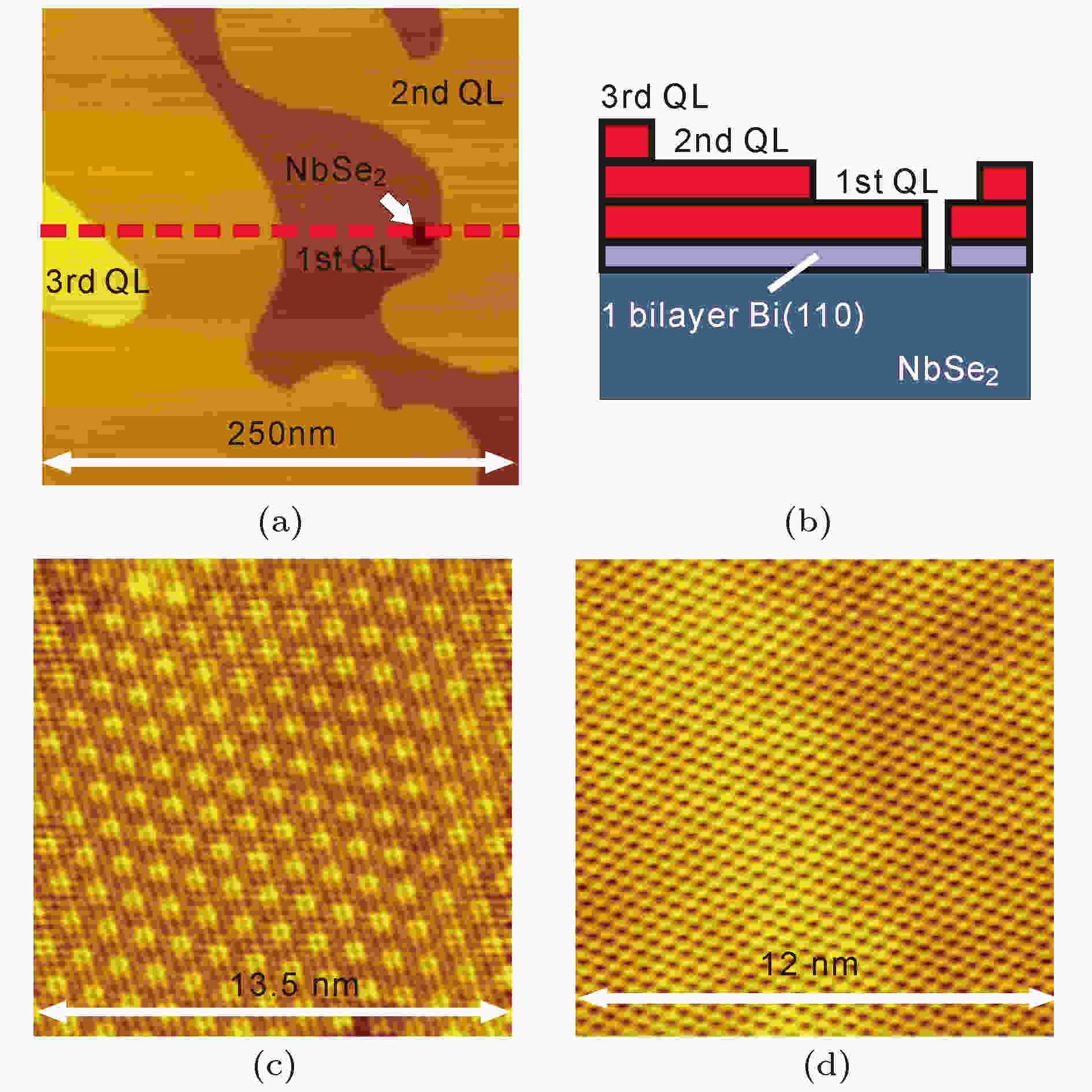 图 1 (a)在NbSe2衬底上生长的Bi2Se3薄膜的形貌; (b)Bi2Se3/NbSe2异质结示意图; (c)NbSe2衬底表面的原子分辨STM图; (d) Bi2Se3薄膜表面的原子分辨STM图[30]
图 1 (a)在NbSe2衬底上生长的Bi2Se3薄膜的形貌; (b)Bi2Se3/NbSe2异质结示意图; (c)NbSe2衬底表面的原子分辨STM图; (d) Bi2Se3薄膜表面的原子分辨STM图[30]Figure1. (a) Morphology of Bi2Se3 thin films grown on NbSe2 substrate; (b) schematic diagram of the Bi2Se3/NbSe2 heterostructure; (c) atomically resolved STM image of the NbSe2 substrate; (d) atomically resolved STM image of the Bi2Se3 film[30].
通过测量表面的微分电导谱(dI/dV)可以获得表面局域态密度(LDOS)的信息. 图2是在NbSe2衬底上生长的厚度分别为3 QL和6 QL的Bi2Se3薄膜表面测得的dI/dV谱. 在4.2 K温度下测得的dI/dV谱显示LDOS在费米能级处有明显的下降, 而在0.4 K温度下可以看到在 ± 1 meV处有非常强的相干峰. 这些都是非常明显的超导能隙的特征. 这些实验结果说明, 在NbSe2衬底上生长的Bi2Se3薄膜在低温下确实变成了超导体, 而且随着磁场或者温度的增加, 零偏压电导(ZBC)增强, 能隙两边相干峰的强度减弱直到消失. 所以通过加磁场和变温测量进一步证明了Bi2Se3薄膜的确发生了超导转变. 另外, 在0.4 K温度下, Bi2Se3薄膜厚度在1 QL—7 QL的范围内都观测到了超导能隙.
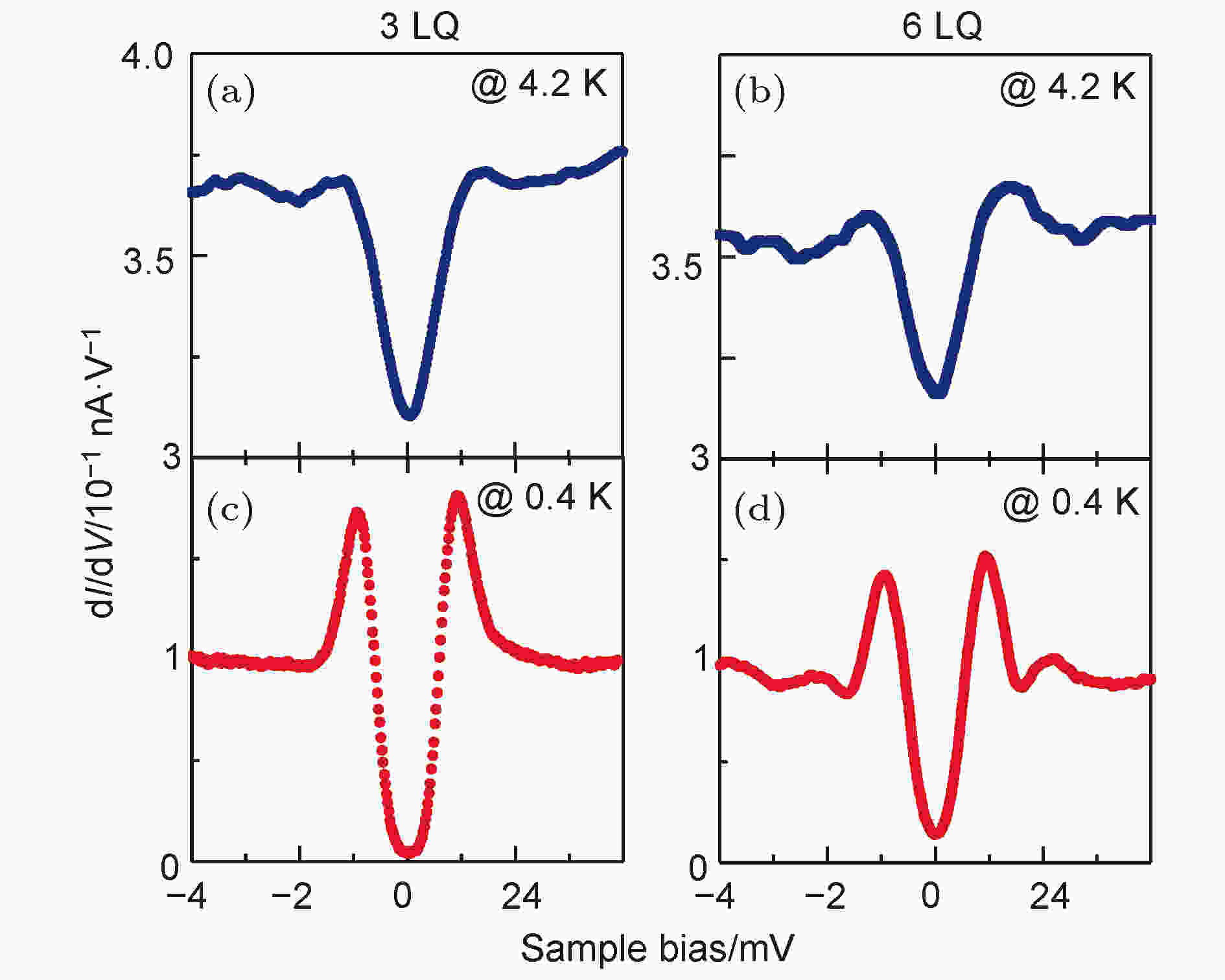 图 2 在Bi2Se3/NbSe2上探测的超导能隙[30] (a) 4.2 K和 (b) 0.4 K温度下3 QL厚的Bi2Se3薄膜的dI/dV谱; (c) 4.2 K和 (d) 0.4 K温度下6 QL厚的Bi2Se3薄膜的dI/dV谱
图 2 在Bi2Se3/NbSe2上探测的超导能隙[30] (a) 4.2 K和 (b) 0.4 K温度下3 QL厚的Bi2Se3薄膜的dI/dV谱; (c) 4.2 K和 (d) 0.4 K温度下6 QL厚的Bi2Se3薄膜的dI/dV谱Figure2. Superconducting energy gap detected in Bi2Se3 thin films grown on NbSe2 substrate[30]: dI/dV spectra measured on 3 QL Bi2Se3 films at (a) 4.2 K and (b) 0.4 K; dI/dV spectra measured on 6 QL Bi2Se3 films at (c) 4.2 K and (d) 0.4 K.
图3是用角分辨光电子能谱(ARPES)测量的在NbSe2衬底上生长的不同厚度的Bi2Se3薄膜的能带结构. ARPES显示, 3 QL厚的Bi2Se3薄膜, 在费米能级以下0.6 eV处, 有明显的能隙特征, 与本征的3 QL厚的Bi2Se3薄膜的能隙的位置不同, 这是由于Bi2Se3薄膜和衬底之间发生了电荷转移, 导致薄膜中费米面的位置发生了改变. 电荷转移增加了表面的电场梯度, 从而增强了Rashba自旋轨道耦合作用, 这导致费米能级以下0.15 eV处的能带发生了劈裂(图3(a)). 当薄膜的厚度增加到6 QL时, 体能隙消失, Dirac点出现, 位于费米能级以下0.45 eV, 这说明表面和界面的电子态的耦合变得很弱(图3(b)). 接近费米面的能带没有发生劈裂, 说明当厚度增加到6 QL时, 表面的电场作用不大. 在NbSe2衬底上生长的6 QL厚的Bi2Se3薄膜的Dirac点非常明显, 这说明界面非常平整和锐利. Dirac点在9 QL和12 QL厚的薄膜中也被观测到了. 这些ARPES结果说明当Bi2Se3薄膜发生超导转变时, 拓扑表面态仍然保留着.
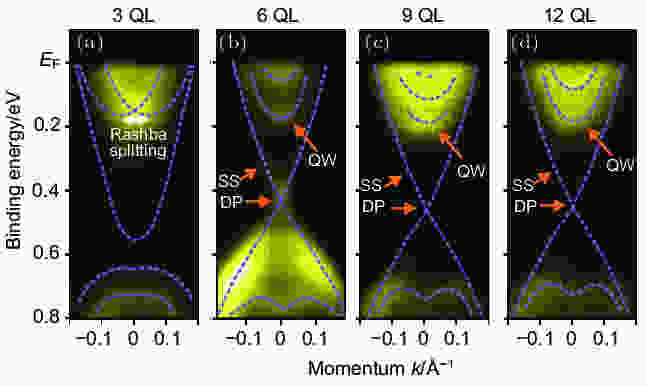 图 3 厚度为 (a) 3 QL, (b) 6 QL, (c) 9 QL, (d) 12 QL 的Bi2Se3/NbSe2的能带结构[30]
图 3 厚度为 (a) 3 QL, (b) 6 QL, (c) 9 QL, (d) 12 QL 的Bi2Se3/NbSe2的能带结构[30]Figure3. Band structure of (a) 3 QL, (b) 6 QL, (c) 9 QL, (d) 12 QL Bi2Se3 thin films grown on NbSe2 substrate[30].
2
2.2.Bi2Te3/NbSe2异质结
超导电性和拓扑表面态共存使得Bi2Se3/NbSe2异质结成为探测Majorana 束缚态的理想平台. 然而拓扑表面态只出现在厚于6 QL的Bi2Se3薄膜中[30,45], 在这种厚度下超导近邻效应会变得非常弱. 而对于Bi2Te3薄膜, 拓扑表面态在厚度为3 QL时就会出现[46], 所以在NbSe2衬底上生长Bi2Te3薄膜可以在超导近邻效应更强的情况下探测Majorana 束缚态[31].在NbSe2衬底上Bi2Te3薄膜的生长模式和Bi2Se3薄膜的生长模式一样, 都是层状生长(图4(a)). 当薄膜厚度达到一定程度时, 薄膜上下两个表面的表面态之间的相互耦合变得很弱, 具有拓扑非平庸的Dirac圆锥型的拓扑表面态才会出现, 在Si(111)衬底上Bi2Te3薄膜的厚度得达到2 QL以上[46-48]. 在NbSe2衬底上, STS数据显示Bi2Te3薄膜能带结构随厚度增加也有与Bi2Se3薄膜类似的变化(图4(c)和图4(d)). 当Bi2Te3薄膜的厚度增加到3 QL时, dI/dV谱线在价带顶(VBM)和导带底(CBM)之间呈不对称的U型(图4(c)). 随着Bi2Te3薄膜厚度的增加, 这个不对称的U型往束缚能增加的方向移动, 与此同时U型部分的能量宽度保持不变. 这说明在NbSe2衬底上, 当Bi2Te3薄膜厚度达到3 QL时, Bi2Te3薄膜中出现拓扑表面态. 这和Si(111)衬底上Bi2Te3薄膜的情况类似[46]. 随着层厚增加, 费米能级的位置向下移动, 厚度达到5 QL时, 费米能级几乎位于体能隙中(图4(d)).
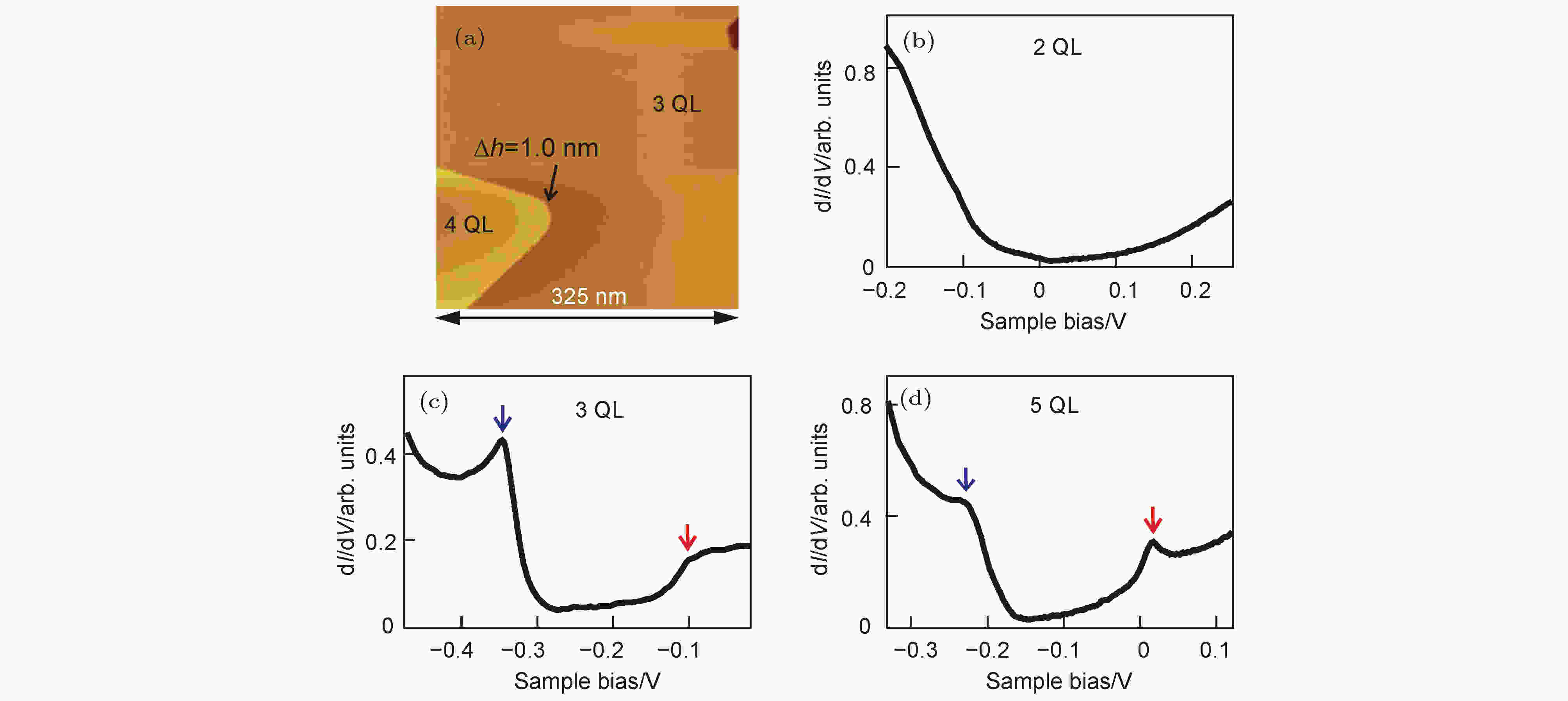 图 4 (a)在NbSe2衬底上生长的Bi2Te3薄膜的形貌; (b) 2 QL, (c) 3 QL, (d) 5 QL Bi2Te3/NbSe2在4.2 K温度下测得的dI/dV谱[31]
图 4 (a)在NbSe2衬底上生长的Bi2Te3薄膜的形貌; (b) 2 QL, (c) 3 QL, (d) 5 QL Bi2Te3/NbSe2在4.2 K温度下测得的dI/dV谱[31]Figure4. (a) Morphology of Bi2Te3 thin films grown on NbSe2 substrate; dI/dV spectra measured at 4.2 K on (b) 2 QL, (c) 3 QL, (d) 5 QL Bi2Te3/NbSe2[31].
在NbSe2衬底上生长的Bi2Te3薄膜, 当厚度达到11 QL时, 在0.4 K下都能观测到非常明显的超导能隙(图5(a)). 图5(b)给出了NbSe2衬底表面以及2 QL和3 QL厚的Bi2Te3薄膜的dI/dV谱线. 直到厚度为2 QL时, STS谱线在零偏压附近都是平的, 微分电导数值为零, STS谱线可以被BCS型谱函数拟合得非常好(图5(b)). 从1 QL到11 QL厚度上测得的dI/dV谱线都用s波BCS型曲线拟合, 数据整理在图5(c)中. 超导能隙随着薄膜厚度增加呈指数衰减, 这与超导近邻效应诱导的超导能隙随距离的衰减趋势在定性上来讲是一致的. 另外, 当薄膜厚度大于2 QL时, STS谱线在零偏压附近不是平的, 而且微分电导数值不为零. STS谱线不能被BCS型谱函数完全拟合(图5(b)). 这可能是由于随着薄膜厚度不断增加, 在达到3 QL厚时, 拓扑表面态在薄膜中出现. 拓扑表面态的出现对dI/dV谱线产生了重要影响, 使之偏离s波BCS谱型[49,50]. 为了证实这一点, 将3 QL厚的Bi2Se3薄膜在0.4 K测得的dI/dV谱线也与标准的BCS隧穿谱进行了比较(图5(c) 插图), 可以看出它比3 QL厚的Bi2Te3薄膜的拟合符合得更好. 因此可以做出判断, 拓扑表面态在超导近邻效应下可以发生超导转变, 它会使超导能隙的BCS谱型发生偏离. 换言之, Bi2Te3/NbSe2异质结是人工构造的拓扑超导体[31].
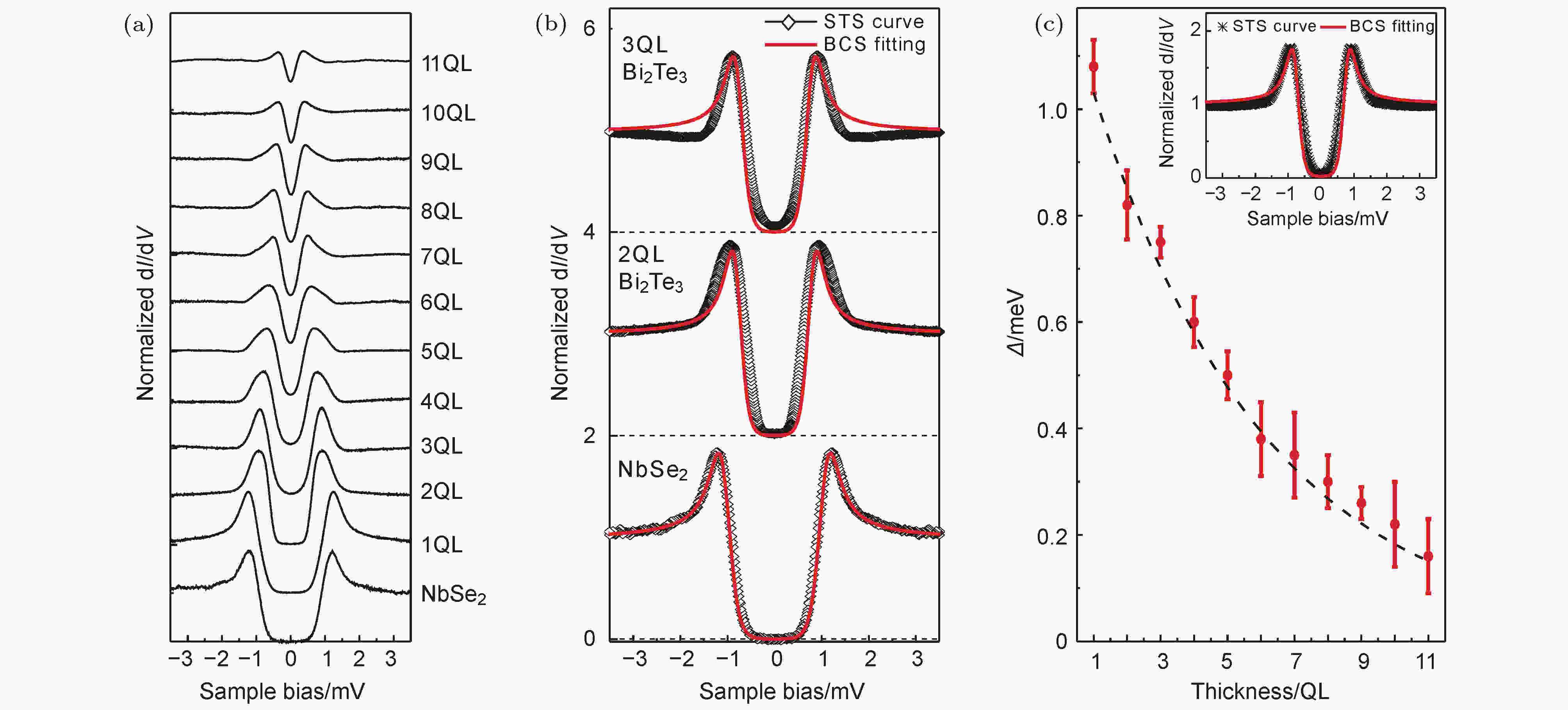 图 5 在Bi2Te3/NbSe2上探测的超导能隙[31] (a)各种厚度的Bi2Te3薄膜上测得的超导能隙; (b)在NbSe2衬底, 2 QL以及3 QL Bi2Te3/NbSe2上测得的超导能隙; (c)超导能隙随厚度的变化, 插图为3 QL Bi2Se3/NbSe2的超导能隙. 这些dI/dV谱都是在0.4 K温度下测量的
图 5 在Bi2Te3/NbSe2上探测的超导能隙[31] (a)各种厚度的Bi2Te3薄膜上测得的超导能隙; (b)在NbSe2衬底, 2 QL以及3 QL Bi2Te3/NbSe2上测得的超导能隙; (c)超导能隙随厚度的变化, 插图为3 QL Bi2Se3/NbSe2的超导能隙. 这些dI/dV谱都是在0.4 K温度下测量的Figure5. Superconducting energy gap observed on Bi2Te3/NbSe2[31]: (a) A series of dI/dV spectra taken on different thicknesses of Bi2Te3 thin films at 0.4 K; (b) dI/dV spectra taken on pristine NbSe2, 2 QL, and 3 QL Bi2Te3/NbSe2; (c) thickness dependence of the superconducting energy gap; Inset is the dI/dV spectra measured at 0.4 K on 3 QL Bi2Se3/NbSe2.
最近, Xu等[51]利用极低温高分辨的ARPES在7 QL Bi2Se3/NbSe2的能带结构中直接观测到了拓扑表面态的超导能隙. 图6(a)展示了4 QL Bi2Se3/NbSe2的能带分布. 位于波矢k1的表面电子态和位于波矢k2的体电子态随温度的变化分别显示在图6(b)和图6(c)中. 在低温下超导信号的特征非常明显, 温度升高到7 K以上时, 相干峰和超导能隙都消失. 对于7 QL Bi2Se3/NbSe2, Dirac点清晰可见, 而且表面态是拓扑非平庸的(图6(d)). 位于波矢k1的拓扑表面电子态(图6(e))和位于波矢k2的体电子态(图6(f))的超导信号的特征也很明显. 这些数据非常强有力地说明了拓扑超导体/NbSe2异质结是研究超导近邻效应诱导的新奇物理现象的理想平台.
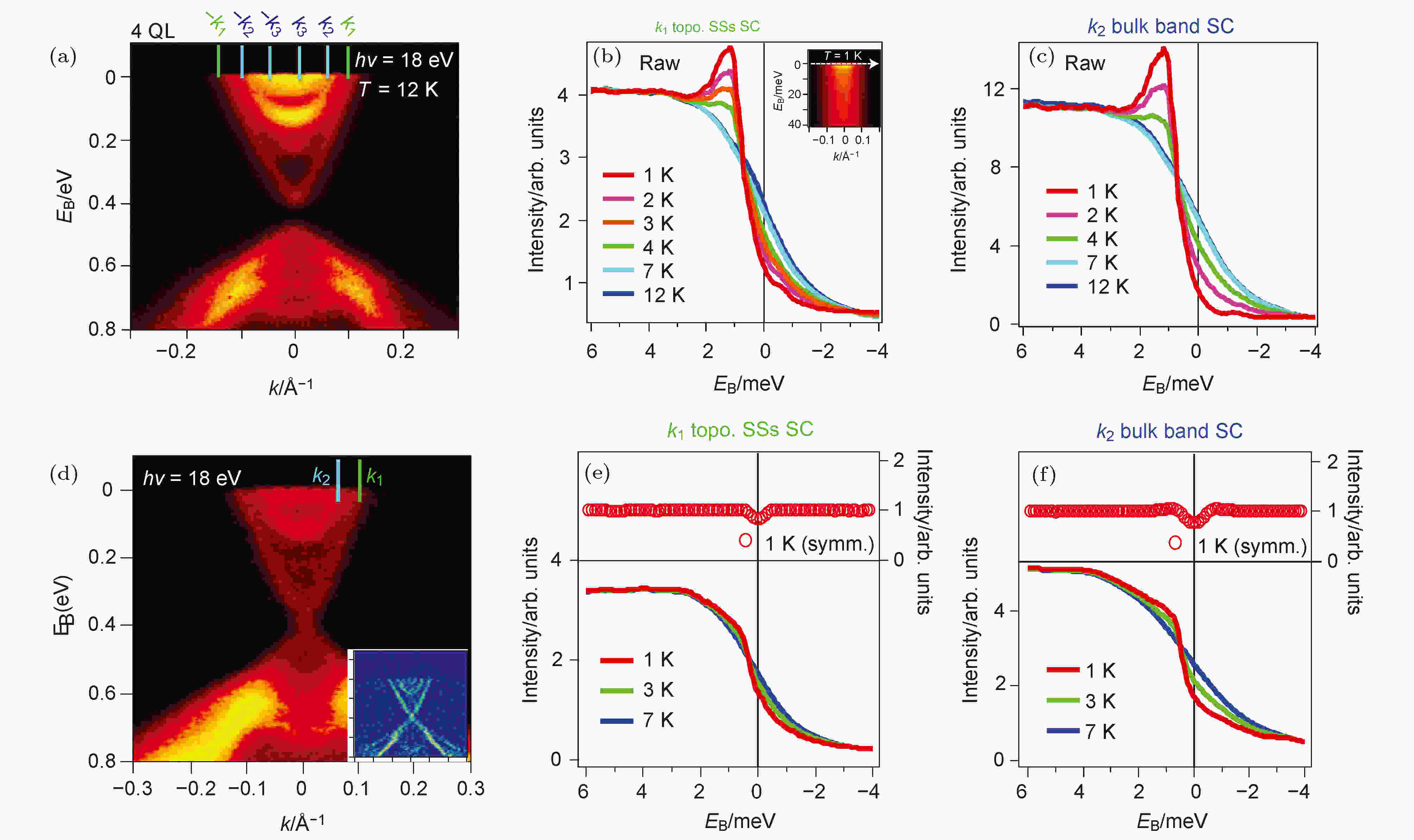 图 6 (a) 12 K时测得的4 QL Bi2Se3/NbSe2的能带结构, 入射光子能量为18 eV; 4 QL 厚的Bi2Se3/NbSe2在 (b) k1和 (c) k2处的ARPES谱随温度的变化关系; (d) 12 K时测得的7 QL Bi2Se3/NbSe2的能带结构, 入射光子能量为18 eV; 7 QL 厚的Bi2Se3/NbSe2在 (e) k1和(f) k2处的ARPES谱随温度的变化关系[51]
图 6 (a) 12 K时测得的4 QL Bi2Se3/NbSe2的能带结构, 入射光子能量为18 eV; 4 QL 厚的Bi2Se3/NbSe2在 (b) k1和 (c) k2处的ARPES谱随温度的变化关系; (d) 12 K时测得的7 QL Bi2Se3/NbSe2的能带结构, 入射光子能量为18 eV; 7 QL 厚的Bi2Se3/NbSe2在 (e) k1和(f) k2处的ARPES谱随温度的变化关系[51]Figure6. (a) Band structure of a 4 QL Bi2Se3/NbSe2 measured at 12 K using an incident photon energy of 18 eV; Temperature dependence of ARPES spectra at (b) k1 and (c) k2 indicated in Fig. (a); (d) Band structure of a 7 QL Bi2Se3/NbSe2 measured at 12 K using an incident photon energy of 18 eV; Temperature dependence of ARPES spectra at (e) k1 and (f) k2 indicated in Fig. (d)[51].
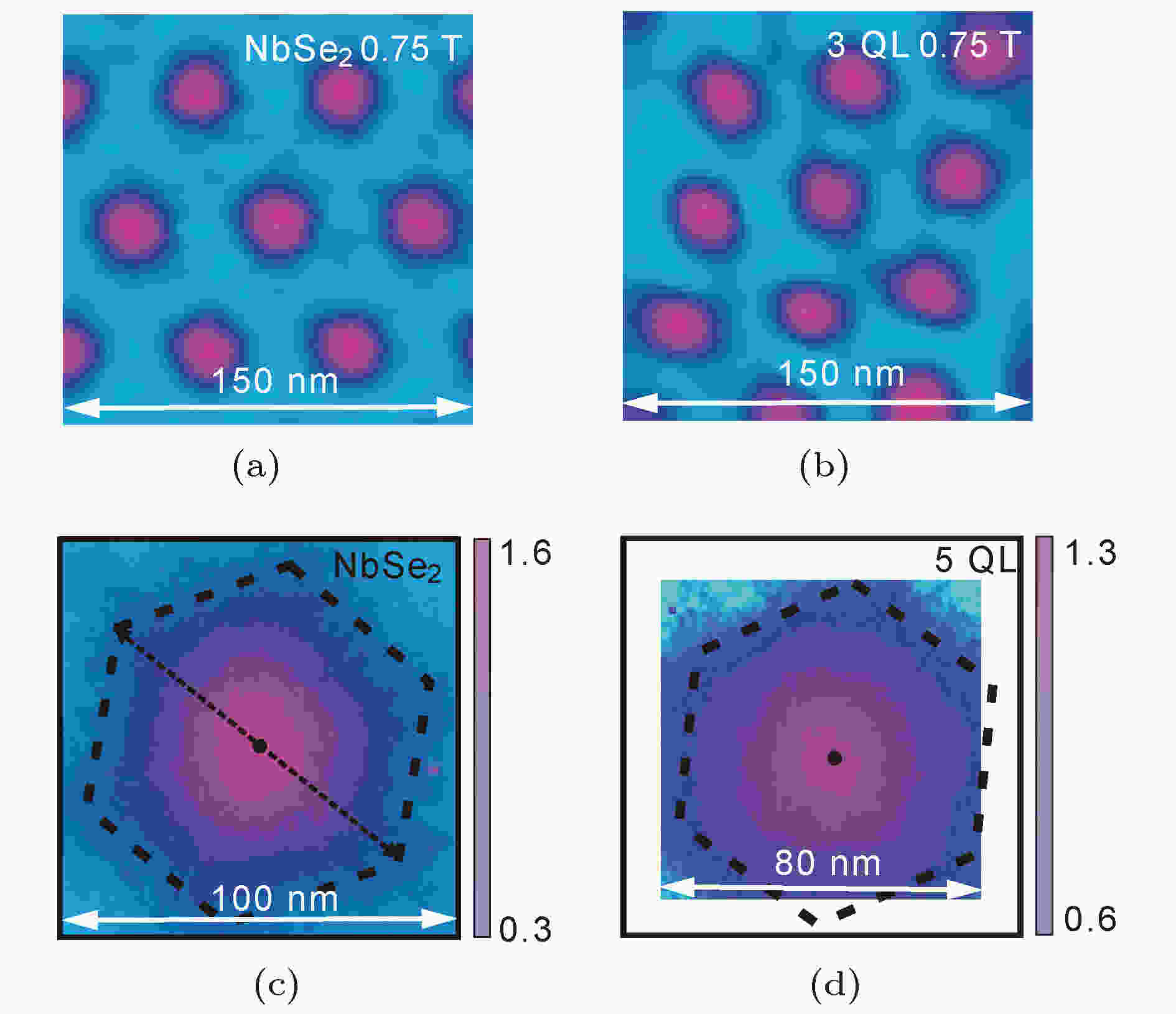 图 7 在0.4 K和0.75 T下在 (a) NbSe2和 (b) 3 QL Bi2Te3/NbSe2上的零偏压电导的映射图; 在 (c) NbSe2和 (d) 5 QL Bi2Te3/NbSe2上单个涡旋的零偏压电导的映射图[31]
图 7 在0.4 K和0.75 T下在 (a) NbSe2和 (b) 3 QL Bi2Te3/NbSe2上的零偏压电导的映射图; 在 (c) NbSe2和 (d) 5 QL Bi2Te3/NbSe2上单个涡旋的零偏压电导的映射图[31]Figure7. Large-scale zero-bias dI/dV maps measured at 0.4 K and 0.75 T on (a) NbSe2 and (b) 3 QL Bi2Te3/NbSe2; Zero-bias dI/dV maps for a single vortex measured at 0.4 K and 0.1 T on (c) NbSe2 and (d) 5 QL Bi2Te3/NbSe2[31].
Xu等[31]系统地研究了不同厚度的Bi2Te3薄膜中涡旋的空间分布. 穿过涡旋中心的ZBC的线型可以用Ginzburg-Landau (GL)公式拟合得非常好[53]. NbSe2衬底和3 QL Bi2Te3/NbSe2中测得的实验数据与拟合结果显示在图8(a)中, 可以看出, 在0.4 K和0.1 T下, NbSe2的超导相干长度ξNbSe2 = 16 nm, 3 QL Bi2Te3/NbSe2的超导相干长度ξ3QL = 29 nm. 在其他厚度的样品上也做了类似的测量和分析, 图8(b)显示Bi2Te3薄膜的相干长度随着厚度的增加而单调增加. 之前报道的NbSe2单晶的超导相干长度在7.2—28.2 nm之间[54,55], 所以图8(a)中得到的ξNbSe2 = 16 nm是合理的. 对于Bi2Te3薄膜, 超导相干长度可以用公式


 图 8 (a)在0.4 K和0.1 T下在NbSe2和3 QL Bi2Te3/NbSe2上得到的穿过涡旋中心的零偏压电导轮廓图; (b) Bi2Te3/NbSe2的超导相干长度与薄膜厚度的依赖关系; (c) 5 QL Bi2Te3/NbSe2的超导相干长度与磁场强度的依赖关系[31]
图 8 (a)在0.4 K和0.1 T下在NbSe2和3 QL Bi2Te3/NbSe2上得到的穿过涡旋中心的零偏压电导轮廓图; (b) Bi2Te3/NbSe2的超导相干长度与薄膜厚度的依赖关系; (c) 5 QL Bi2Te3/NbSe2的超导相干长度与磁场强度的依赖关系[31]Figure8. (a) Normalized ZBC profiles crossing through the centers of vortices at 0.4 K and 0.1 T on NbSe2 and 3 QL Bi2Te3/NbSe2; (b) thickness dependence of the coherence length; (c) the coherence length as a function of the magnetic field measured on 5 QL Bi2Te3/NbSe2[31].
通过施加垂直于样品表面的磁场, 在Bi2Te3/NbSe2表面能够观测到磁通涡旋. 如图9所示, 在5 QL Bi2Te3/NbSe2, NbSe2, 2 QL Bi2Te3/NbSe2单个涡旋中心都观测到了零偏压峰(ZBP). 但是通过细致比较, 可以发现5 QL Bi2Te3/NbSe2样品与另外两种样品中ZBP随磁场的变化情况有所不同. 图9(a)是5 QL厚的Bi2Te3薄膜在涡旋中心处各种磁场强度下测得的dI/dV谱. 在磁场小于0.1 T时, ZBP的强度非常大. 当磁场达到0.18 T时, ZBP的强度开始明显变弱. NbSe2的涡旋中心的ZBP在磁场变化下就没有发生这种明显的变化(图9(b)). 在普通s波超导体中, 当磁场强度低于临界磁场Hc2时, 涡旋的密度和磁场强度呈正比, 而单个涡旋的结构对外部磁场不敏感, 从而在涡旋中心附近的LDOS应该不会随外部的磁场增加而发生变化, 所以在5 QL Bi2Te3/NbSe2中观测到的ZBP反常现象不是由NbSe2衬底引起的. 2 QL 厚的Bi2Te3/NbSe2的涡旋中心的ZBP在磁场变化下也没有发生这种明显的变化(图9(c)). 在2 QL Bi2Te3薄膜中拓扑表面态还没有完全形成, 涡旋中心的ZBP主要来自于体能带的电子态, 所以在5 QL Bi2Te3/NbSe2中观测到的ZBP反常现象也不是来自于普通超导近邻效应. 排除了这几种可能性后, 5 QL Bi2Te3/NbSe2中观测到的ZBP反常现象应该和5 QL 厚的Bi2Te3薄膜的拓扑表面态的超导电性有关.
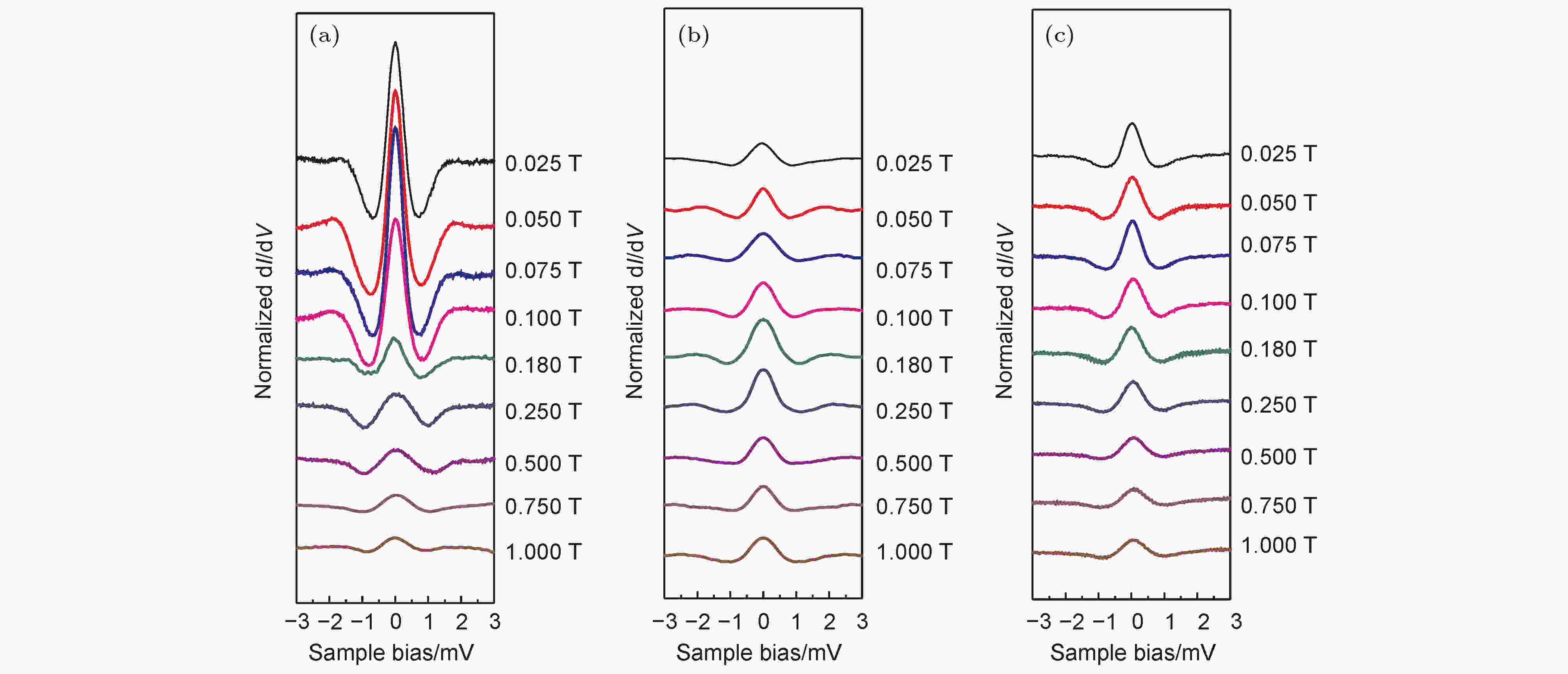 图 9 (a) 5 QL Bi2Te3/NbSe2, (b) NbSe2, (c) 2 QL Bi2Te3/NbSe2单个涡旋中心处的dI/dV谱随磁场强度的变化关系[32]
图 9 (a) 5 QL Bi2Te3/NbSe2, (b) NbSe2, (c) 2 QL Bi2Te3/NbSe2单个涡旋中心处的dI/dV谱随磁场强度的变化关系[32]Figure9. Magnetic field-dependent dI/dV spectra taken at a vortex center of (a) 5 QL Bi2Te3/NbSe2, (b) pristine NbSe2, and (c) 2 QL Bi2Te3/NbSe2[32].
图10(a)显示了一个5 QL 厚的Bi2Te3薄膜在0.1 T的外加磁场下的ZBC空间分布. 磁通涡旋清晰可见, 在涡旋的中心区域, 超导电性受到磁场的作用最强, 所以ZBC在中心区域最高. 沿着图10(a)中黑色虚线箭头的方向, 从涡旋中心到远离中心处测得的一系列的dI/dV谱线显示在图10(b)中. 在涡旋中心处测得的dI/dV谱线在零偏压时有一个尖峰, 而在离中心距离为r的地方这个峰劈裂为两个, 而且劈裂的能量间隔与距离呈线性关系.
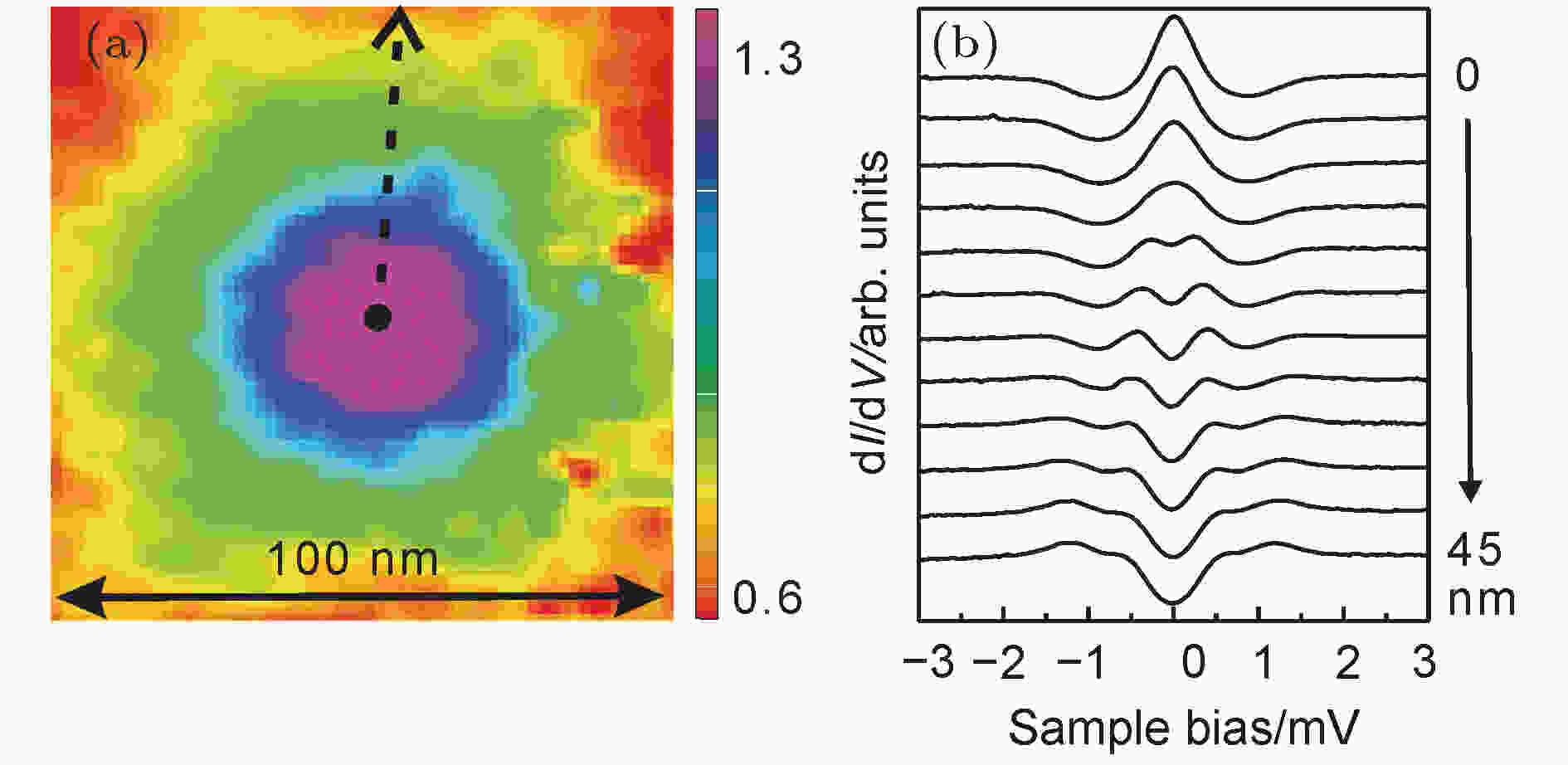 图 10 (a)在0.4 K和0.1 T下在5 QL Bi2Te3/NbSe2上单个涡旋的零偏压电导映射图; (b)沿着图(a)中虚线方向做的一系列随空间演化的dI/dV谱[32]
图 10 (a)在0.4 K和0.1 T下在5 QL Bi2Te3/NbSe2上单个涡旋的零偏压电导映射图; (b)沿着图(a)中虚线方向做的一系列随空间演化的dI/dV谱[32]Figure10. (a) A vortex mapped by zero bias dI/dV on 5 QL Bi2Te3/NbSe2 at 0.1 T and 0.4 K; (b) spatially resolved dI/dV spectra taken along the dashed line in Fig. (a)[32].
为了便于比较, 各种厚度的Bi2Te3薄膜磁通涡旋中dI/dV谱的强度随磁通中心距离和偏压的对应关系显示在图11中, 其中在超导能隙中发生劈裂的两个峰的位置用“×”标记. 每幅图中沿着劈裂的两个峰画出虚线显示, 劈裂的能量间隔与距离呈线性关系. 虚线相交的地方给出了发生劈裂的起始位置. 从1 QL到6 QL厚的Bi2Te3薄膜的实验数据分别显示在图11(a)—图11(f)中. 对于不同厚度的Bi2Te3薄膜, 虽然在离涡旋中心20 nm的地方都能看见劈裂的两个峰, 但是两条虚线相交的位置即开始劈裂的位置在不同厚度的薄膜中明显不同. 对于1 QL—3 QL厚的Bi2Te3薄膜, 峰的劈裂是从涡旋中心处就开始, 即V型劈裂, 这和普通的s波超导体, 比如NbSe2的情况类似[52,57]. 与此相反, 对于4 QL—6 QL厚的Bi2Te3薄膜, 峰的劈裂是在离中心一段距离之后才发生, 即Y型劈裂, 这和普通的s波超导体的情况明显不同.
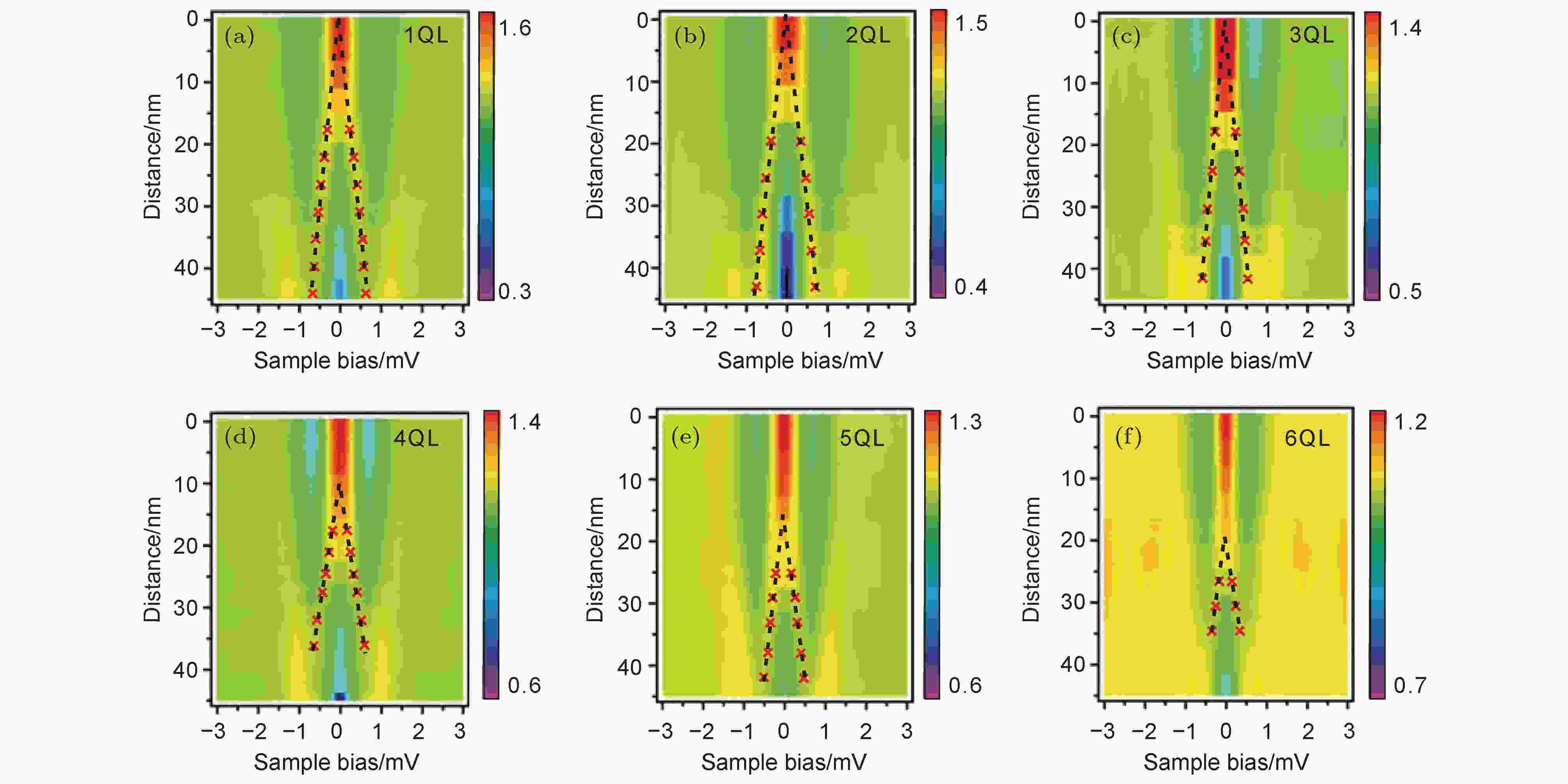 图 11 (a) 1 QL, (b) 2 QL, (c) 3 QL, (d) 4 QL, (e) 5 QL, (f) 6 QL Bi2Te3/NbSe2在0.10 T外加磁场下测得的涡旋中束缚态随空间演化的dI/dV谱强度图[32]
图 11 (a) 1 QL, (b) 2 QL, (c) 3 QL, (d) 4 QL, (e) 5 QL, (f) 6 QL Bi2Te3/NbSe2在0.10 T外加磁场下测得的涡旋中束缚态随空间演化的dI/dV谱强度图[32]Figure11. Spatially resolved bound states within a vortex at 0.10 T in (a) 1 QL, (b) 2 QL, (c) 3 QL, (d) 4 QL, (e) 5 QL, (f) 6 QL Bi2Te3/NbSe2 heterostructures[32].
这种涡旋中束缚态在离中心有限距离的地方开始劈裂的行为在这之前还没有被人报道过, 这个新特征和局域电子结构的拓扑性质有关. 对于4 QL—6 QL厚的Bi2Te3薄膜, 费米能级位于拓扑表面态的顶端并且和导带底部相交[32]. 涡旋中的LDOS来自于体电子态和拓扑表面态两个部分. 体电子态的超导行为和普通的超导体行为类似. 如果表面态中存在Majorana零能模, dI/dV的线型应该会发生变化. Chiu 等[56]对Majorana零能模在涡旋中的空间分布已经进行了理论研究, 他们计算了Nb/Bi2Se3/Nb三明治结构的LDOS. 计算结果表明, 在涡旋中心处Majorana零能模在dI/dV谱线中的零偏压处有一个尖峰, 而且在离涡旋中心附近40 nm的范围内这个对应Majorana零能模的尖峰都存在. Bi2Te3/NbSe2异质结也有类似的结构, 所以Majorana零能模也应该有类似的空间分布. Majorana零能模应该对涡旋中心附近r范围内的零偏压处的LDOS都有增强效应, 所以在涡旋中心附近r范围内Majorana零能模对零偏压处的LDOS有很大的贡献, 零偏压电导始终表现为一个尖峰. 在离涡旋中心附近r范围以外的地方Majorana零能模对零偏压处的LDOS的贡献变小, 普通准粒子态的贡献变大, 从而零偏压电导的尖峰发生劈裂. 这应该是图11中涡旋附近束缚态在有限距离r以外才发生劈裂的内在物理机理.
图12显示5 QL Bi2Te3/NbSe2的单个涡旋中束缚态在0.10 T时呈Y型劈裂, ZBP在离中心15 nm的地方才发生劈裂(图12(a)), 而当磁场增加到0.18 T时束缚态呈V型劈裂, ZBP从中心处就开始发生劈裂(图12(b)). 这种现象可以用邻近涡旋之间的相互作用来解释. 当磁场很小时, 涡旋之间的距离远大于涡旋本身的尺寸, 所以涡旋之间的作用可以忽略不计. 而当磁场增加到0.18 T时, 相邻涡旋之间的距离减小, 而且磁场越强超导相干长度也变得越长, 所以涡旋之间的作用会变强到足以破坏Majorana零能模. 在这种情况下, 涡旋中心的LDOS只会来自普通束缚态的贡献, 峰的劈裂从涡旋中心就开始, 即呈V型劈裂. 更重要的是图9, 图11和图12中的现象有密切的联系. 对于普通超导体比如NbSe2和2 QL Bi2Te3/NbSe2, 磁通中心的ZBP随磁场没有明显的变化, 磁通中束缚态呈V型劈裂, 而对于拓扑超导体比如5 QL Bi2Te3/NbSe2, 当磁场强度较低时(< 0.18 T), 磁通中心的ZBP强度非常大, 这时磁通中束缚态呈Y型劈裂, 当磁场强度较大时(≥ 0.18 T), 磁通中心的ZBP强度会明显变弱, 这时磁通中束缚态呈V型劈裂.
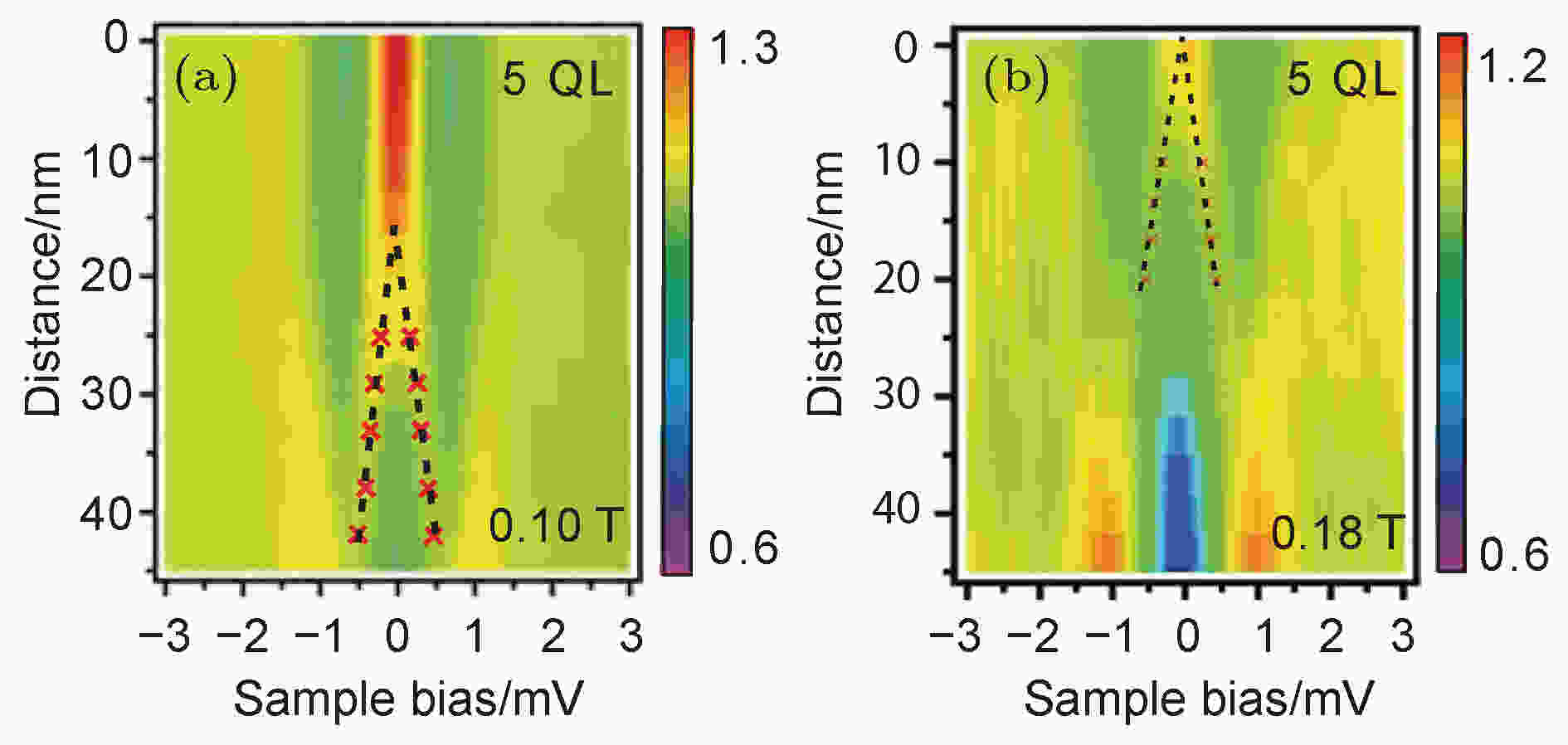 图 12 (a)在0.10 T外加磁场下5 QL Bi2Te3/NbSe2的单个涡旋中心处束缚态随空间演化的dI/dV谱强度图; (b)在0.18 T外加磁场下5 QL Bi2Te3/NbSe2的单个涡旋中心处束缚态随空间演化的dI/dV谱强度图, 束缚态从一开始就发生劈裂, 这与图(a)形成鲜明的对比[32]
图 12 (a)在0.10 T外加磁场下5 QL Bi2Te3/NbSe2的单个涡旋中心处束缚态随空间演化的dI/dV谱强度图; (b)在0.18 T外加磁场下5 QL Bi2Te3/NbSe2的单个涡旋中心处束缚态随空间演化的dI/dV谱强度图, 束缚态从一开始就发生劈裂, 这与图(a)形成鲜明的对比[32]Figure12. (a) Spatially resolved bound states within a vortex at 0.10 T in the 5 QL Bi2Te3/NbSe2 heterostructures; (b) spatially resolved bound states within a vortex at 0.18 T in the 5 QL Bi2Te3/NbSe2 heterostructures. The peak-splitting start point is zero, in sharp contrast to that in Fig. (a)[32].
总之, 通过在普通s波超导体NbSe2衬底上生长拓扑绝缘体薄膜, 可以得到非常锐利的拓扑绝缘体/超导体界面. 超导近邻效应被证实可以引起拓扑表面态发生超导转变. 一系列自洽的实验数据都显示在Bi2Te3/NbSe2异质结涡旋中心有Majorana零能模的存在. 涡旋里束缚态在离中心有限距离的地方才发生劈裂是Majorana存在的有力证据, 这个结论被最近的研究超导近邻诱导的拓扑表面态涡旋中Majorana零能模的理论计算所证实[58]. 由于拓扑表面态受到时间反演对称性的保护, Majorana零能模不会受到杂质和缺陷的散射. 另外, Majorana零能模的湮灭可以通过增加磁场来实现, 所以这些研究为通过操控Majorana费米子以达到量子计算的目的提供了有效的途径.
自旋极化STM/STS技术是研究纳米尺度下固体表面电子态自旋性质非常有力的工具[60]. Sun等[33]利用自旋极化的STM针尖系统地测量了拓扑绝缘体/超导体异质结的磁通涡旋中束缚态的自旋分布, 测量结果如图13所示. 当STM针尖自旋极化方向与外部磁场一致时, 磁通涡旋中心的零能峰要明显高于方向不一致的情况(图13(b)), 而在离磁通涡旋中心10 nm远的地方测得的零能峰的强度则没有明显差别(图13(c)), 这与Majorana零能模引起的自旋选择Andreev反射效应相符. 理论计算表明, 磁通涡旋中有Majorana零能模存在时, 在磁通涡旋中心处与外加磁场方向一致的电子和空穴占多数[33,61]. 当外加磁场方向向上时, 由于磁通涡旋中心自旋向上的电子和空穴占多数, 磁化方向向上的STM针尖中自旋向上的电子更容易从针尖入射到拓扑超导体的Majorana零能模中; 而磁化方向向下的STM针尖中自旋向下的电子则无法被Majorana零能模吸收, 从而直接被反射回去, 所以当STM针尖自旋极化方向与外部磁场一致时测得的ZBP要高于方向不一致的情况. 而且Majorana零能模有一定的空间分布, 在离磁通涡旋10 nm远的地方自旋方向相反的电子和空穴的占据数差别小, 从而在ZBP上没有明显区别.
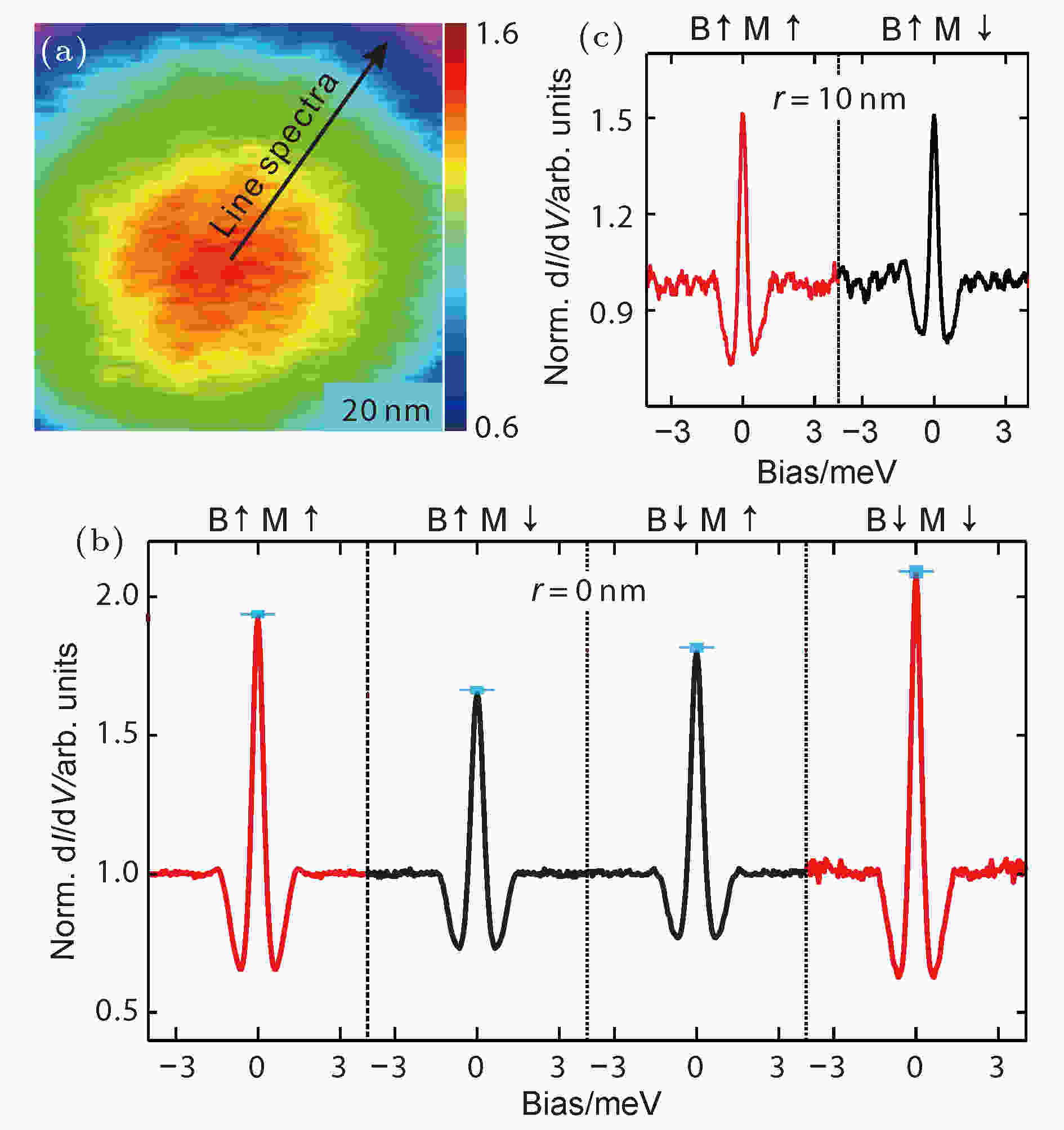 图 13 (a)拓扑超导体5 QL Bi2Te3/NbSe2在0.1 T外加磁场下磁通涡旋的零偏压dI/dV映射图; (b)在磁通涡旋中心用自旋极化的针尖测得的dI/dV谱; (c)在离磁通涡旋中心10 nm远的地方用自旋极化的针尖测得的dI/dV谱[33]
图 13 (a)拓扑超导体5 QL Bi2Te3/NbSe2在0.1 T外加磁场下磁通涡旋的零偏压dI/dV映射图; (b)在磁通涡旋中心用自旋极化的针尖测得的dI/dV谱; (c)在离磁通涡旋中心10 nm远的地方用自旋极化的针尖测得的dI/dV谱[33]Figure13. (a) Zero bias dI/dV mapping of a vortex at 0.1 T on the topological superconductor 5 QL Bi2Te3/NbSe2. (b) dI/dV at the vortex center measured with a fully spin polarized tip. (c) dI/dV at 10 nm away from the center measured with a fully spin polarized tip[33].
利用Majorana零能模可以引起自旋选择Andreev反射效应这个特点, Sun等[33]还用自旋极化的STM针尖测量了多种其他不含有Majorana零能模的情况(图14). 3 QL Bi2Te3/NbSe2和NbSe2属于普通超导体, 用自旋极化的针尖测得的ZBP强度没有明显的差异(图14(a)和 图14(b)). 5 QL Bi2Te3/NbSe2虽然是拓扑超导体, 但是当磁场强度增加到大于0.2 T后, 用自旋极化的针尖测得的ZBP强度也没有明显的差异(图14(c)). 这是因为随着磁场的增强, 磁通涡旋之间的距离减小, 每个磁通涡旋中的Majorana零能模之间的作用增强, 当磁通涡旋之间的距离减小到一定程度后Majorana零能模发生湮灭, 从而在磁通涡旋中心的ZBP强度与外加磁场以及针尖磁化方向没有明显的依赖关系.
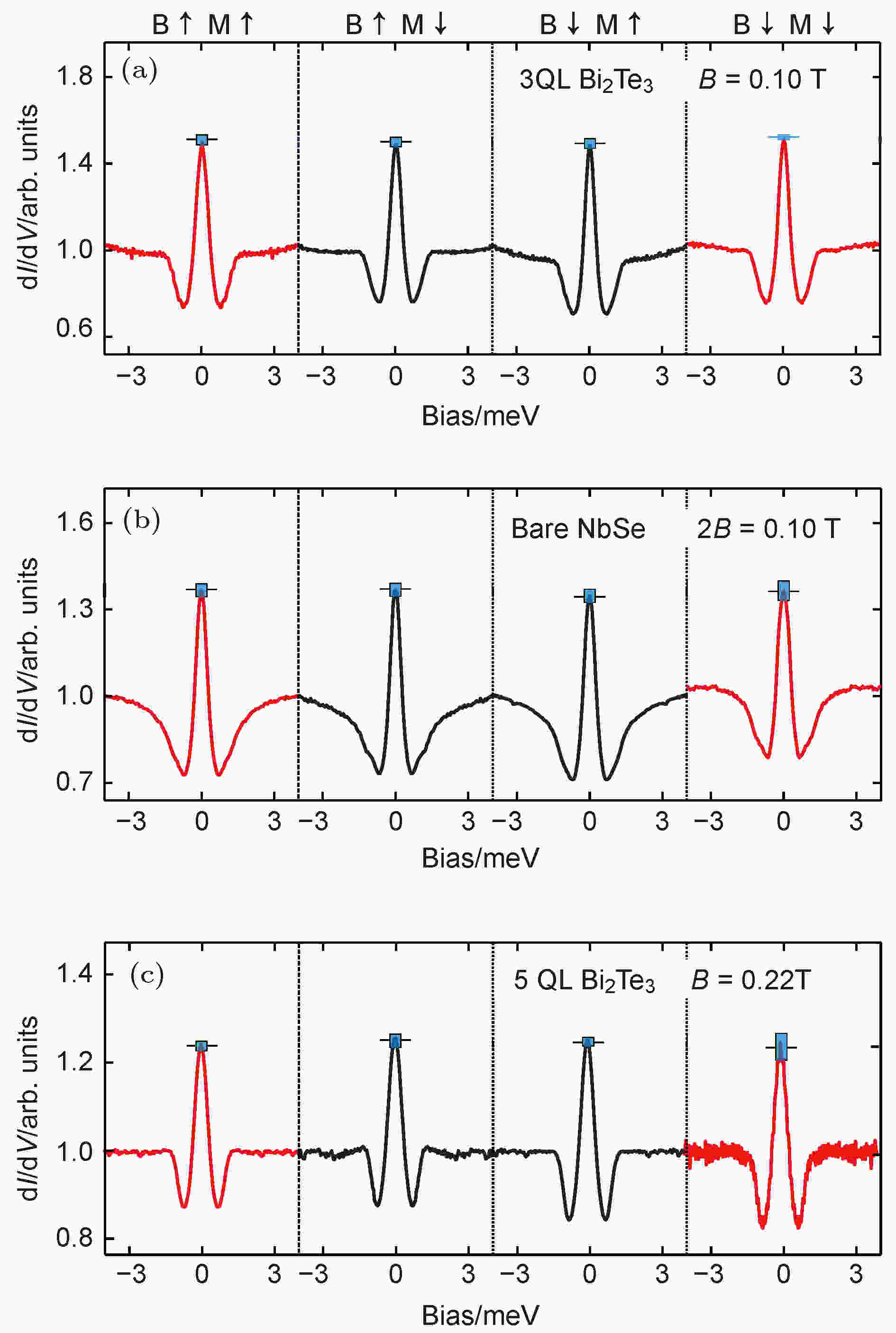 图 14 用自旋极化的针尖在磁通涡旋中心测得的dI/dV谱[33] (a) 3 QL Bi2Te3/NbSe2, B = 0.1 T; (b) NbSe2, B = 0.1 T; (c) 5 QL Bi2Te3/NbSe2, B = 0.22 T
图 14 用自旋极化的针尖在磁通涡旋中心测得的dI/dV谱[33] (a) 3 QL Bi2Te3/NbSe2, B = 0.1 T; (b) NbSe2, B = 0.1 T; (c) 5 QL Bi2Te3/NbSe2, B = 0.22 TFigure14. dI/dV curves at the center of a vortex core measured with a fully spin polarized tip[33]: (a) 3 QL Bi2Te3/NbSe2, B = 0.1 T; (b) Bare NbSe2, B = 0.1 T; (c) 5 QL Bi2Te3/NbSe2, B = 0.22 T.
利用自旋极化STM/STS技术测量拓扑绝缘体/超导体异质结磁通涡旋中束缚态的自旋分布的实验, 证实了Majorana零能模引起的自旋选择Andreev反射效应, 揭示了Majorana零能模具有特殊的磁性质, 更进一步有力地证明了在该体系中存在着Majorana费米子.
总之, 人们对理论预言存在Majorana束缚态的体系已经展开了实验研究. 虽然ZBP是Majorana零能模的一个特征[62], 但是它的其他性质也应该被实验探测到, 比如分数Josephson效应[63]、量子化电导[64,65]、非局域性质[66-68]、以及非Abelian统计特性[7]. 所以, 还需要从理论和实验上进一步揭示Majorana零能模的特殊性质. 最近人们利用高分辨ARPES证实在铁基超导体FeTe0.55Se0.45表面的费米面附近存在拓扑表面态[69], 极低温STM/STS在FeTe0.55Se0.45表面的磁通涡旋中看到了Majorana零能模[70]. 另外, 在(Li0.84Fe0.16)OHFeSe[71]表面的磁通涡旋中也看到了Majorana零能模. FeTe0.55Se0.45的超导转变温度有14.5 K, (Li0.84Fe0.16)OHFeSe的超导转变温度有42 K. 超导转变温度越高, 超导能隙越大, 越有利于存储和探测Majorana零能模, 这意味着不久的将来可以实现在液氦温度以上来调控Majorana费米子. 这些研究工作将会激发人们越来越大的兴趣来探索Majorana费米子新奇的物理性质.
